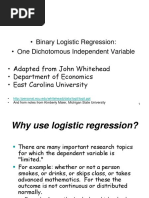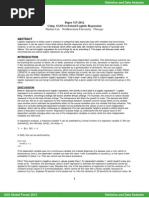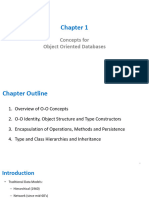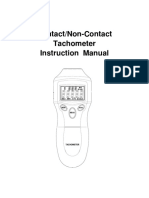0 ratings0% found this document useful (0 votes)
13 viewsLogistic Regression
Logistic Regression
Uploaded by
Anaswara K UCopyright
© © All Rights Reserved
Available Formats
Download as PDF, TXT or read online on Scribd
0 ratings0% found this document useful (0 votes)
13 viewsLogistic Regression
Logistic Regression
Uploaded by
Anaswara K UCopyright
© © All Rights Reserved
Available Formats
Download as PDF, TXT or read online on Scribd
You are on page 1/ 4
8.3.
7 Logistic Regression
Logistic regression is both classification and regression
technique depending on the scenario used. Logistic regression
(logit regression) is a type of regression analysis used for
predicting the outcome of a categorical dependent variable
similar to OLS regression. In logistic regression, dependent
variable (Y) is binary (0,1) and independent variables (X) are
continuous in nature. The probabilities describing the possible
outcomes (probability that Y = 1) of a single trial are modelled
as a logistic function of the predictor variables. In the logistic
regression model, there is no R2 to gauge the fit of the overall
model; however, a chi-square test is used to gauge how well
the logistic regression model fits the data. The goal of logistic
regression is to predict the likelihood that Y is equal to 1
(probability that Y = 1 rather than 0) given certain values of X.
That is, if X and Y have a strong positive linear relationship,
the probability that a person will have a score of Y = 1 will
increase as values of X increase. So, we are predicting
probabilities rather than the scores of the dependent variable.
For example, we might try to predict whether or not a small
project will succeed or fail on the basis of the number of years
of experience of the project manager handling the project. We
presume that those project managers who have been managing
projects for many years will be more likely to succeed. This
means that as X (the number of years of experience of project
manager) increases, the probability that Y will be equal to 1
(success of the new project) will tend to increase. If we take a
hypothetical example in which 60 already executed projects
were studied and the years of experience of project managers
ranges from 0 to 20 years, we could represent this tendency to
increase the probability that Y = 1 with a graph.
To illustrate this, it is convenient to segregate years of
experience into categories (i.e. 0–8, 9–16, 17–24, 25–32, 33–
40). If we compute the mean score on Y (averaging the 0s and
1s) for each category of years of experience, we will get
something like
When the graph is drawn for the above values of X and Y, it
appears like the graph in Figure 8.18. As X increases, the
probability that Y = 1 increases. In other words, when the
project manager has more years of experience, a larger
percentage of projects succeed. A perfect relationship
represents a perfectly curved S rather than a straight line, as
was the case in OLS regression. So, to model this relationship,
we need some fancy algebra / mathematics that accounts for
the bends in the curve.
An explanation of logistic regression begins with an
explanation of the logistic function, which always takes values
between zero and one. The logistic formulae are stated in
terms of the probability that Y = 1, which is referred to as P.
The probability that Y is 0 is 1 − P.
FIG. 8.18 Logistic regression
The ‘ln’ symbol refers to a natural logarithm and a + bX is
the regression line equation. Probability (P) can also be
computed from the regression equation. So, if we know the
regression equation, we could, theoretically, calculate the
expected probability that Y = 1 for a given value of X.
‘exp’ is the exponent function, which is sometimes also
written as e.
Let us say we have a model that can predict whether a
person is male or female on the basis of their height. Given a
height of 150 cm, we need to predict whether the person is
male or female.
We know that the coefficients of a = −100 and b = 0.6.
Using the above equation, we can calculate the probability of
male given a height of 150 cm or more formally P(male|height
= 150).
y = e^(a + b × X)/(1 + e^(a + b × X))
y = exp ( −100 + 0.6 × 150)/(1 + EXP( −100 + 0.6 × X)
y = 0.000046
or a probability of near zero that the person is a male.
Assumptions in logistic regression
The following assumptions must hold when building a logistic
regression model:
There exists a linear relationship between logit function and independent
variables
The dependent variable Y must be categorical (1/0) and take binary value,
e.g. if pass then Y = 1; else Y = 0
The data meets the ‘iid’ criterion, i.e. the error terms, ε, are independent from
one another and identically distributed
The error term follows a binomial distribution [n, p]
n = # of records in the data
p = probability of success (pass, responder)
8.3.8 Maximum Likelihood Estimation
The coefficients in a logistic regression are estimated using a
process called Maximum Likelihood Estimation (MLE). First,
let us understand what is likelihood function before moving to
You might also like
- Unit 9 Simple Linear Regression: StructureNo ratings yetUnit 9 Simple Linear Regression: Structure22 pages
- Regression With A Binary Dependent VariableNo ratings yetRegression With A Binary Dependent Variable63 pages
- Course Title: Quantitative Techniques For Economics Course Code: ECON6002 Topic: The Linear Probability Model (LPM)No ratings yetCourse Title: Quantitative Techniques For Economics Course Code: ECON6002 Topic: The Linear Probability Model (LPM)12 pages
- Briefly Discuss The Concept of LR AnalysisNo ratings yetBriefly Discuss The Concept of LR Analysis9 pages
- Handout 05 Regression and Correlation PDFNo ratings yetHandout 05 Regression and Correlation PDF17 pages
- Random Variables: Corr (X, Y) Cov (X, Y) / Cov (X, Y) Is The Covariance (X, Y)No ratings yetRandom Variables: Corr (X, Y) Cov (X, Y) / Cov (X, Y) Is The Covariance (X, Y)15 pages
- Qualitative Response Regression QuestionsNo ratings yetQualitative Response Regression Questions10 pages
- Exp 2 121a1047 ML Lavanya Kurup Div C C3No ratings yetExp 2 121a1047 ML Lavanya Kurup Div C C38 pages
- Data Science and Bigdata Analytics: Dr. Ali Imran JehangiriNo ratings yetData Science and Bigdata Analytics: Dr. Ali Imran Jehangiri20 pages
- Classification-Introduction, Logistic RegressionNo ratings yetClassification-Introduction, Logistic Regression26 pages
- In All The Regression Models That We Have Considered So100% (1)In All The Regression Models That We Have Considered So52 pages
- Module 6 RM: Advanced Data Analysis TechniquesNo ratings yetModule 6 RM: Advanced Data Analysis Techniques23 pages
- Chapter 13 Quick Overview of Correlation and Linear RegressionNo ratings yetChapter 13 Quick Overview of Correlation and Linear Regression17 pages
- Qualitative Response Regression Models 1No ratings yetQualitative Response Regression Models 129 pages
- IC Multiple Project Dashboard 10918 PowerPointNo ratings yetIC Multiple Project Dashboard 10918 PowerPoint10 pages
- Questionsrelatedto MLand Deep Learning Presentation ANo ratings yetQuestionsrelatedto MLand Deep Learning Presentation A4 pages
- A Rational Function Is One That Can Be Written As A Polynomial100% (1)A Rational Function Is One That Can Be Written As A Polynomial20 pages
- Setup Serial Serial Serial Serial Serial Serial: Void Begin Println Print Println Println PrintlnNo ratings yetSetup Serial Serial Serial Serial Serial Serial: Void Begin Println Print Println Println Println5 pages
- Computing International Roughness Index of Roads From Longitudinal Profile MeasurementsNo ratings yetComputing International Roughness Index of Roads From Longitudinal Profile Measurements16 pages
- Tutorial - The Computer Music Guide To Soundfonts100% (1)Tutorial - The Computer Music Guide To Soundfonts15 pages
- 05_PowerScale+Upgrades-SSP+-+Participant+GuideNo ratings yet05_PowerScale+Upgrades-SSP+-+Participant+Guide27 pages
- Diagram of AS9100 Rev D Implementation ProcessNo ratings yetDiagram of AS9100 Rev D Implementation Process1 page
- Contact/Non-Contact Tachometer Instruction ManualNo ratings yetContact/Non-Contact Tachometer Instruction Manual7 pages
- Beginning OpenGL Game Programming Second Edition Luke (Luke Benstead) Benstead - Download the ebook with all fully detailed chapters100% (1)Beginning OpenGL Game Programming Second Edition Luke (Luke Benstead) Benstead - Download the ebook with all fully detailed chapters49 pages
- Course Title: Quantitative Techniques For Economics Course Code: ECON6002 Topic: The Linear Probability Model (LPM)Course Title: Quantitative Techniques For Economics Course Code: ECON6002 Topic: The Linear Probability Model (LPM)
- Random Variables: Corr (X, Y) Cov (X, Y) / Cov (X, Y) Is The Covariance (X, Y)Random Variables: Corr (X, Y) Cov (X, Y) / Cov (X, Y) Is The Covariance (X, Y)
- Data Science and Bigdata Analytics: Dr. Ali Imran JehangiriData Science and Bigdata Analytics: Dr. Ali Imran Jehangiri
- In All The Regression Models That We Have Considered SoIn All The Regression Models That We Have Considered So
- Chapter 13 Quick Overview of Correlation and Linear RegressionChapter 13 Quick Overview of Correlation and Linear Regression
- Mathematical Equality: Fundamentals and ApplicationsFrom EverandMathematical Equality: Fundamentals and Applications
- Correlation and Regression: Six Sigma Thinking, #8From EverandCorrelation and Regression: Six Sigma Thinking, #8
- Questionsrelatedto MLand Deep Learning Presentation AQuestionsrelatedto MLand Deep Learning Presentation A
- A Rational Function Is One That Can Be Written As A PolynomialA Rational Function Is One That Can Be Written As A Polynomial
- Setup Serial Serial Serial Serial Serial Serial: Void Begin Println Print Println Println PrintlnSetup Serial Serial Serial Serial Serial Serial: Void Begin Println Print Println Println Println
- Computing International Roughness Index of Roads From Longitudinal Profile MeasurementsComputing International Roughness Index of Roads From Longitudinal Profile Measurements
- Beginning OpenGL Game Programming Second Edition Luke (Luke Benstead) Benstead - Download the ebook with all fully detailed chaptersBeginning OpenGL Game Programming Second Edition Luke (Luke Benstead) Benstead - Download the ebook with all fully detailed chapters

























































































